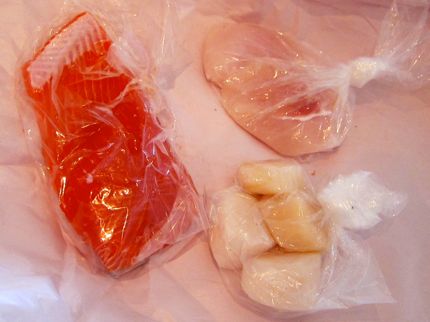Bronzed Albacore Tuna
June 30, 2012
Bronzed Albacore Tuna
Wine Varietal: Pinot Noir
Serves 4
Bronzing fish is a more gentle way of cooking the tender flesh than blackening, which many cooks remember from its heyday in the 1980s when Cajun cuisine was all the rage. According to cookbook author Carol Foster in her book, “Short Cuts to Great Cuisine,” from which this recipe originated, “Bronzing, as opposed to the blackening cooking method, allows the home cook to enjoy juicy, tender, spice-encrusted fish without an accompanying smoke alarm. Since blackening requires a cast-iron skillet to reach at least 500 degrees, it creates a blinding amount of smoke that only a commercial vent can handle. The tamer bronzing method requires only 350 degrees, a reasonable alternative. Another advantage to bronzing is that all the fillets can be cooked at once; blackening requires that one fillet be cooked at a time, wiping out the skillet in between.” Carol’s original recipe called for red snapper, but she suggests substituting any firm-fleshed fish, such as salmon or tuna. I have chosen the Northwest’s own albacore tuna, which has its annual run in the summer, and suggest pairing it with a good-quality Oregon Pinot Noir.
2 teaspoons sweet paprika
1 1/2 teaspoons dried thyme, crumbled
1 1/2 teaspoons dried oregano, crumbled
1 teaspoon kosher salt
1/2 teaspoon freshly ground black pepper
1/4 teaspoon ground cayenne pepper
3/4 cup unsalted butter
1 1/2 pounds tuna loin or steaks, 3/4-inch thick, rinsed, drained, patted dry, cut into four (6-ounce) pieces, and brought to room temperature before cooking, if time permits
1. In a small bowl, blend the paprika, thyme, oregano, salt, black pepper, and cayenne. Melt the butter in a small skillet and keep over low heat.
2. Place a large cast-iron skillet over medium-high heat. When the skillet is very hot, dip the tuna pieces in the butter and sprinkle both sides evenly with the spice mixture. Place in skillet immediately (do not place on another surface or the spices will be lost) and cook about 3 minutes. Turn and cook another 2 minutes, depending upon the thickness and degree of doneness desired. Transfer the fish to a warmed serving plate.
3. Pour the remaining warm butter into the cast-iron skillet, scraping up any browned bits and spices that may have accumulated on the bottom. Pour over the fish and serve immediately.




No Comments »
No comments yet.
RSS feed for comments on this post. TrackBack URL
Leave a comment